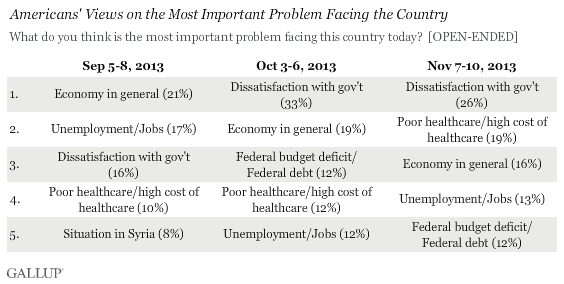WASHINGTON, D.C. -- The percentage of Americans mentioning healthcare as the country's most important problem increased to 19% in November from 12% in October, as technical issues with the federal health insurance website continue and the White House faces criticism over people being dropped from their health plans. Healthcare now ranks second behind dissatisfaction with government as the top problem, but ahead of the economy in general, unemployment, and the federal debt.

Mentions of poor healthcare or the high cost of healthcare as a top problem in the Nov. 7-10 survey have nearly doubled since September and are higher now than in any month since the Affordable Care Act become law in March 2010. This suggests that recent troubles with the federal health exchange website and other problems with the healthcare law's rollout, including accusations that President Barack Obama misled Americans about keeping their current coverage, may be fueling public concern.
The 26% of Americans who mention dissatisfaction with government as the top problem this month is down slightly from a record high of 33% in October. The still-high level of frustration with government is consistent with record-low congressional approval in November and the president's job approval rating hovering near his personal low.
This month marks the first time since 2007 that non-economic issues have occupied the top two spots on Americans' list of most important problems. Fewer Americans have been mentioning the economy in general or unemployment specifically this year, possibly reflecting their increasing confidence in the economy.
Implications
Dysfunctional government has replaced the economy and unemployment as Americans' top concerns, and mentions of healthcare have increased in November to a three-year high. While fewer mentions of the economy and unemployment may suggest that Americans have grown more satisfied with each, it is more likely that the recent spate of problems in Washington has focused Americans' concerns on government leadership and healthcare, eclipsing their concern about routine economic issues. It is possible that the spike in Americans' worries about these two issues will prove temporary, and that mentions of the economy and unemployment will increase in coming months.
Survey Methods
Results for this Gallup poll are based on telephone interviews conducted Nov. 7-10, 2013, with a random sample of 1,039 adults, aged 18 and older, living in all 50 U.S. states and the District of Columbia.
For results based on the total sample of national adults, one can say with 95% confidence that the margin of sampling error is ±4 percentage points.
Interviews are conducted with respondents on landline telephones and cellular phones, with interviews conducted in Spanish for respondents who are primarily Spanish-speaking. Each sample of national adults includes a minimum quota of 50% cellphone respondents and 50% landline respondents, with additional minimum quotas by region. Landline and cell telephone numbers are selected using random-digit-dial methods. Landline respondents are chosen at random within each household on the basis of which member had the most recent birthday.
Samples are weighted to correct for unequal selection probability, nonresponse, and double coverage of landline and cell users in the two sampling frames. They are also weighted to match the national demographics of gender, age, race, Hispanic ethnicity, education, region, population density, and phone status (cellphone only/landline only/both, and cellphone mostly). Demographic weighting targets are based on the March 2012 Current Population Survey figures for the aged 18 and older U.S. population. Phone status targets are based on the July-December 2011 National Health Interview Survey. Population density targets are based on the 2010 census. All reported margins of sampling error include the computed design effects for weighting.
In addition to sampling error, question wording and practical difficulties in conducting surveys can introduce error or bias into the findings of public opinion polls.
View methodology, full question results, and trend data.
For more details on Gallup's polling methodology, visit www.gallup.com.
